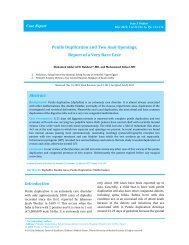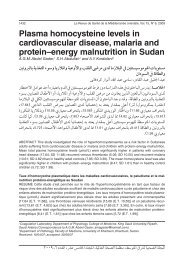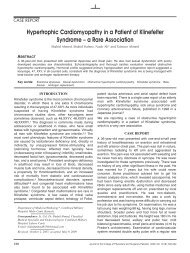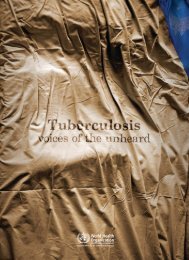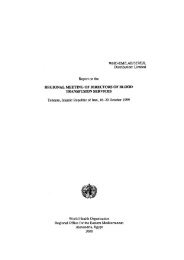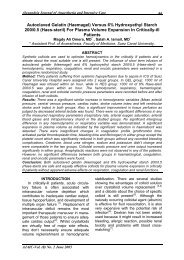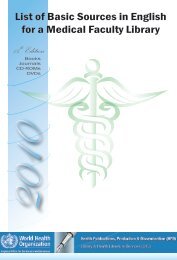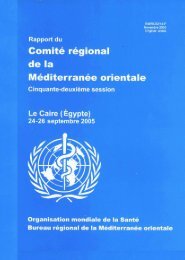Tobacco use in shisha: Studies on waterpipe smoking
Tobacco use in shisha: Studies on waterpipe smoking
Tobacco use in shisha: Studies on waterpipe smoking
Create successful ePaper yourself
Turn your PDF publications into a flip-book with our unique Google optimized e-Paper software.
2.2 Subjects and methods<br />
In 2002, a smok<str<strong>on</strong>g>in</str<strong>on</strong>g>g and morbidity questi<strong>on</strong>naire accompanied a predesigned hepatitis<br />
C virus survey <str<strong>on</strong>g>in</str<strong>on</strong>g> order to identify the additi<strong>on</strong>al health hazards described above. A<br />
representative sample of six Egyptian governorates (of a total 27) was targeted, represent<str<strong>on</strong>g>in</str<strong>on</strong>g>g<br />
governorates <str<strong>on</strong>g>in</str<strong>on</strong>g> both Upper and Lower Egypt. Of the total populati<strong>on</strong> of 70 milli<strong>on</strong>, about<br />
20 milli<strong>on</strong> citizens <str<strong>on</strong>g>in</str<strong>on</strong>g>habit these governorates. [12, 13] A cluster sample technique was<br />
<str<strong>on</strong>g>use</str<strong>on</strong>g>d to recruit <str<strong>on</strong>g>in</str<strong>on</strong>g>dividuals from each governorate. The sample comprised 6950 <str<strong>on</strong>g>in</str<strong>on</strong>g>dividuals.<br />
An <str<strong>on</strong>g>in</str<strong>on</strong>g>terview ho<str<strong>on</strong>g>use</str<strong>on</strong>g>hold survey was carried out. The questi<strong>on</strong>naire c<strong>on</strong>ta<str<strong>on</strong>g>in</str<strong>on</strong>g>ed secti<strong>on</strong>s <strong>on</strong><br />
the follow<str<strong>on</strong>g>in</str<strong>on</strong>g>g topics:<br />
• sociodemographic data<br />
• smok<str<strong>on</strong>g>in</str<strong>on</strong>g>g pattern, type, durati<strong>on</strong>, and amount<br />
• history of hypertensi<strong>on</strong> and <str<strong>on</strong>g>in</str<strong>on</strong>g>take of medicati<strong>on</strong> (to treat hypertensi<strong>on</strong>)<br />
• abnormal high blood glucose and history of diabetes mellitus type 2.<br />
All adults above 18 years old <str<strong>on</strong>g>in</str<strong>on</strong>g> the ho<str<strong>on</strong>g>use</str<strong>on</strong>g>hold were <str<strong>on</strong>g>in</str<strong>on</strong>g>terviewed. Blood pressure, random<br />
blood glucose and anthropometric measurements were evaluated. The follow<str<strong>on</strong>g>in</str<strong>on</strong>g>g steps were<br />
followed.<br />
Field nurses and physicians were <str<strong>on</strong>g>in</str<strong>on</strong>g>formed and tra<str<strong>on</strong>g>in</str<strong>on</strong>g>ed <strong>on</strong> blood pressure measurement<br />
and other anthropometric measurements and tested for reliability of their work. Also the steps<br />
to be followed <str<strong>on</strong>g>in</str<strong>on</strong>g> the cl<str<strong>on</strong>g>in</str<strong>on</strong>g>ic were stuck <strong>on</strong> the wall as a rem<str<strong>on</strong>g>in</str<strong>on</strong>g>der. Anthropometric measurements<br />
taken were weight, height, waist and hip circumferences (WC and HC). Body weight was<br />
measured by a regularly titrated balance. The height was measured by a scale aga<str<strong>on</strong>g>in</str<strong>on</strong>g>st a wall<br />
from the lowest po<str<strong>on</strong>g>in</str<strong>on</strong>g>t at the heel to the highest po<str<strong>on</strong>g>in</str<strong>on</strong>g>t of the head with the subject stand<str<strong>on</strong>g>in</str<strong>on</strong>g>g<br />
upright and head not tilted.<br />
Body mass <str<strong>on</strong>g>in</str<strong>on</strong>g>dex (BMI) was calculated us<str<strong>on</strong>g>in</str<strong>on</strong>g>g the follow<str<strong>on</strong>g>in</str<strong>on</strong>g>g formula: weight divided by<br />
the square of the height (kg/m 2 ). It was further classified <str<strong>on</strong>g>in</str<strong>on</strong>g> adults <str<strong>on</strong>g>in</str<strong>on</strong>g>to: [13,14].<br />
Underweight < 18.5 kg/m 2<br />
Average 24.9–18.5 kg/m 2<br />
Overweight 25–29.9 kg/m 2<br />
Obese ≥30 kg/m 2<br />
The WC was measured with a tape measure comfortably encircl<str<strong>on</strong>g>in</str<strong>on</strong>g>g the smallest abdom<str<strong>on</strong>g>in</str<strong>on</strong>g>al<br />
area below the rib cage and above the umbilicus. A waist circumference of ≥102 cm and ≥88<br />
cm am<strong>on</strong>g adult males and females, respectively, are c<strong>on</strong>sidered to be an <str<strong>on</strong>g>in</str<strong>on</strong>g>dicator of risky<br />
abdom<str<strong>on</strong>g>in</str<strong>on</strong>g>al obesity. [15] The HC was measured with a tape measure placed around the most<br />
protrud<str<strong>on</strong>g>in</str<strong>on</strong>g>g part of the buttocks.<br />
17



